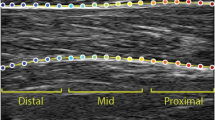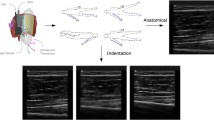Abstract
The number one priority for any manned space mission is the health and safety of its crew. The study of the short and long term physiological effects on humans is paramount to ensuring crew health and mission success. One of the challenges associated in studying the physiological effects of space flight on humans, such as loss of bone and muscle mass, has been that of readily attaining the data needed to characterize the changes. The small sampling size of astronauts, together with the fact that most physiological data collection tends to be rather tedious, continues to hinder elucidation of the underlying mechanisms responsible for the observed changes that occur in space. Better characterization of the muscle loss experienced by astronauts requires that new technologies be implemented. To this end, we have begun to validate a 360° ultrasonic scanning methodology for muscle measurements and have performed empirical sampling of a limb surrogate for comparison. Ultrasonic wave propagation was simulated using 144 stations of rotated arm and calf MRI images. These simulations were intended to provide a preliminary check of the scanning methodology and data analysis before its implementation with hardware. Pulse-echo waveforms were processed for each rotation station to characterize fat, muscle, bone, and limb boundary interfaces. The percentage error between MRI reference values and calculated muscle areas, as determined from reflection points for calf and arm cross sections, was −2.179% and +2.129%, respectively. These successful simulations suggest that ultrasound pulse scanning can be used to effectively determine limb cross-sectional areas. Cross-sectional images of a limb surrogate were then used to simulate signal measurements at several rotation angles, with ultrasonic pulse-echo sampling performed experimentally at the same stations on the actual limb surrogate to corroborate the results. The objective of the surrogate sampling was to compare the signal output of the simulation tool used as a methodology validation for actual tissue signals. The disturbance patterns of the simulated and sampled waveforms were consistent. Although only discussed as a small part of the work presented, the sampling portion also helped identify important considerations such as tissue compression and transducer positioning for future work involving tissue scanning with this methodology.
Similar content being viewed by others
References
LeBlanc A, Rowe R, Schneider V, Evans H, Hedrick T.: Regional Muscle Loss After Short Duration Spaceflight. Aviat Space Environ Med, vol. 66, p. 1151 (1995).
Ferrando AA, Stuart CA, Brunder DG, Hillman GR.: Magnetic Resonance Imaging Quantitation of Changes in Muscle Volume During 7 Days of Strict Bed Rest. Aviat Space Environ Med, vol. 66, p. 976 (1995).
Miyamoto A, Shigematsu T, Fukunaga T, Kawakami K, Mukai C, Sekiguchi C.: Medical Baseline Data Collection on Bone and Muscle Change with Space Flight. Bone, vol. 22, p. 79S (1998).
LeBlanc A, Shackelford L, Schneider V.: Future Human Bone Research in Space. Bone, vol. 22, p. 113S (1998).
National Aeronautics and Space Administration, Johnson Space Center Office of Bioastronautics: Draft Bioastronautics Critical Path Roadmap, JSC 65277 (2004).
National Aeronautics and Space Administration: NASA 2003 Strategic Plan.
National Aeronautics and Space Administration Office of Biological and Physical Research: OBPR’s Research Plan: Our Past Orbit, Our Current Orbit — And Beyond. (2003).
Miyatani M., Kanehisa H., Fukunaga T.: Validity of Bioelectrical Impedance and Ultrasonographic Methods for Estimating the Muscle Volume of the Upper Arm. Eur J Appl Physiol, vol. 82, p 391 (2000).
Miyatani M., Kanehisa H., Kuno S., Nishijima T., Fukunaga T.: Validity of Ultrasonograph Muscle Thickness Measurements for Estimating Muscle Volume of Knee Extensors in Humans. Eur J Appl Physiol, vol. 86, p. 203 (2002).
Morimoto A, Krumm J, Kozlowski D, Kuhlmann J, Wilson C, Little C, Dickey F, Kwok K, Rodgers B, Walsh N.: High Definition 3D Ultrasound Imaging. Stud Health Technol Inform, vol. 39, p. 90 (1997).
LeBlanc A, Lin C, Shackelford L et al.: Muscle Volume, MRI Relaxation Times (T2), and Body Composition after Spaceflight. J Appl Physiol, vol. 89, p. 2158 (2000).
Conley MS, Foley JM, Ploutz-Snyder LL, Meyer RA, Dudley GA.: Effect of Acute Head-Down Tilt on Skeletal Muscle Cross-Sectional Area and Proton Transverse Relaxation Time. J Appl Physiol, vol. 84, p. 1572 (1996).
Mitsiopoulos N, Baumgartner RN, Heymsfield SB, Lyons W, Gallagher D, Ross R.: Cadaver Validation of Skeletal Muscle Measurement by Magnetic Resonance Imaging and Computerized Tomography. J Appl Physiol, vol. 85, p. 115 (1998).
Jadvar H.: Medical Imaging in Microgravity. Aviat Space Environ Med, vol. 71, p. 640 (2000).
Dupont AC, Sauerbrei EE, Fenton PV, Shragge PC, Loeb GE, Richmond FJR.: Real-Time Sonography to Estimate Muscle Thickness: Comparison with MRI and CT. J Clin Ultrasound, vol. 29, p. 230 (2001).
Watkin K, Diouf I, Gallagher T, Logemann J, Rademaker A, Ettema S.: Ultrasonic Quantification of Geniohyoid Cross-Sectional Area and Tissue Composition: a Preliminary Study of Age and Radiation Effects. Head Neck, vol. 23, p. 467 (2001).
Cho Z, Jones J, andSingh M.: Foundations of Medical Imaging, John Wiley & Sons Inc, New York, pgs. 457–548 (1993).
Njeh C, Hans D, Fuerst T, Glüer C andGenant H.: Quantitative Ultrasound: Assessment of Osteoporosis and Bone Status, Martin Dunitz Ltd., London, pgs. 47–65 (1999).
Pillen S, Scholten RR, Zwarts MJ, andVerrips A.: Quantitative Skeletal Muscle Ultrasonography in Children with Suspected Neuromuscular Disease. Muscle Nerve, vol. 27, p. 699 (2003).
Brukx L and Waelkens J.: Evaluation of the Usefulness of a Quantitative Ultrasound Device in Screening Bone Mineral Density in Children. Ann Hum Biol, vol. 30, p. 304 (2003).
Pereira-da-Silva L., Gomes J., Clington A., Videira-Amaral J., andBustamante S.: Upper Arm Measurements of Healthy Neonates Comparing Ultrasonography and Anthropometric Methods. Early Human Development, vol. 54, p 117 (1999).
Author information
Authors and Affiliations
Corresponding author
Rights and permissions
About this article
Cite this article
Hatfield, T.R., Klaus, D.M. & Simske, S.J. An ultrasonic methodology for muscle cross section measurement of support space flight. Microgravity Sci. Technol 15, 3–11 (2004). https://doi.org/10.1007/BF02870959
Received:
Revised:
Accepted:
Issue Date:
DOI: https://doi.org/10.1007/BF02870959




